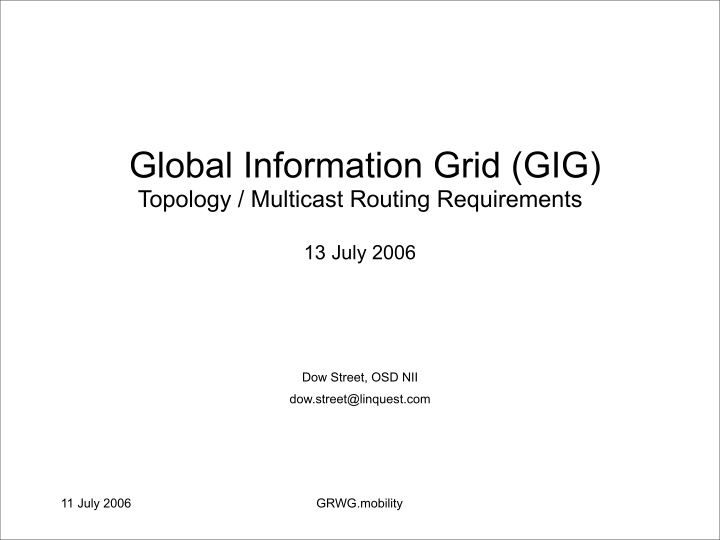



Global Information Grid (GIG) Topology / Multicast Routing Requirements 13 July 2006 Dow Street, OSD NII dow.street@linquest.com 11 July 2006 GRWG.mobility
Background (1) • OSD NII and DISA are leading a large-scale system engineering activity to define the overall network architecture for the Global Information Grid (GIG). • The GIG is likely to push the limits of current approaches and protocols in several areas: routing, QOS, security, etc. • The GIG Routing Working Group (GRWG) is focused on the IP routing part of the problem (unicast and multicast routing). • To be economically viable, the GIG will need to heavily leverage commercial hardware and software. • However, it will be difficult to meet GIG requirements with the current protocols. • The current planning goes to 2015+, which gives some time for modifying existing protocols or developing a new models. 11 July 2006 GRWG.mobility 2
GIG Network Description (1) • The GIG will be a large network: – working estimate of 10^5 routers, 10^7 hosts within 12 years – a few small developments or changes in paradigm could push that to 10^6 routers • The GIG will include many sub-administrations within a single, overarching technical authority. • The GIG will have a wide range of node and link types, from carrier class backbone networks to human portable, battery powered devices. • The GIG will be global in scope. • The GIG will support critical operations. • The GIG will (in all likelihood) make use of IPv6 as the packet format and common convergence layer for enabling connectivity. 11 July 2006 GRWG.mobility 3
GIG Network Description (2) There are several key differences between the Internet and the GIG that impact the applicability of the current Internet protocols: • pervasive network mobility • the nature of routing commons • requirements for security How do these impact multicast? 11 July 2006 GRWG.mobility 4
Pervasive Network Mobility (1) - Multicast Impacts • The GIG will comprise a large number of globally dispersed, geographically mobile networks. • Many of these networks will be carried on vehicles, leading to extensive use of wireless RF. • Vehicle based networks will make up large sections of the network infrastructure as well as connecting to the edge. • RF capacity is quite limited (no option to over-provision), which makes multicast an critical part of the architecture. • RF link intermittency and network/node mobility can cause problems for IP multicast tree construction and maintenance. • E.g. Senders move, receivers move, RPs move or become disconnected, links within the the tree flap, etc • The GRWG has recently kicked-off a study on IP multicast over dynamic topologies. (not quite MANETs, but rather macro-mobile networks) 11 July 2006 GRWG.mobility 5
Nature of the Routing Commons (1) - Multicast Impacts • There is a single overarching authority for all GIG assets with (in theory) dictatorial control over sub-administrations. • GIG users cooperate to accomplish mission goals and share limited global resources - i.e. mission-oriented network commons. • No underlying business model required to motivate multicast deployment - can decree “turn on multicast!” and it will have some effect. • In reality, the “business case” is already there due to widespread use of RF where efficiency gains provided by multicast are critical. • Communities of interest (set of group members) within the network are highly dynamic, global, large, and small. • In some parts of the GIG today , multicast makes up more than 60% of the network traffic. • Both one-to-many (i.e. SSM) and many-to-many (i.e. ASM) information exchange is important. (sensor data, situational awareness) • QOS for multicast traffic may also be required. 11 July 2006 GRWG.mobility 6
Requirements for Security (1) - Multicast Impacts • Security is a principal consideration due to the nature of the environment. • Widespread use of IPsec gateways (tunnel mode) for user traffic – Multicast solution must span multiple network segments with only limited control plan communication between PT and CT networks – Limits the applicability of overlays, ALM, etc which require information exchange between user network and nodes within the infrastructure • Requirement for some control over multicast – Group membership control – Network resources able to be consumed (total multicast, per group, etc) – Rate limiting vs. absolute • GRWG is currently conducting an analysis of requirements in this area. 11 July 2006 GRWG.mobility 7
Recommend
More recommend